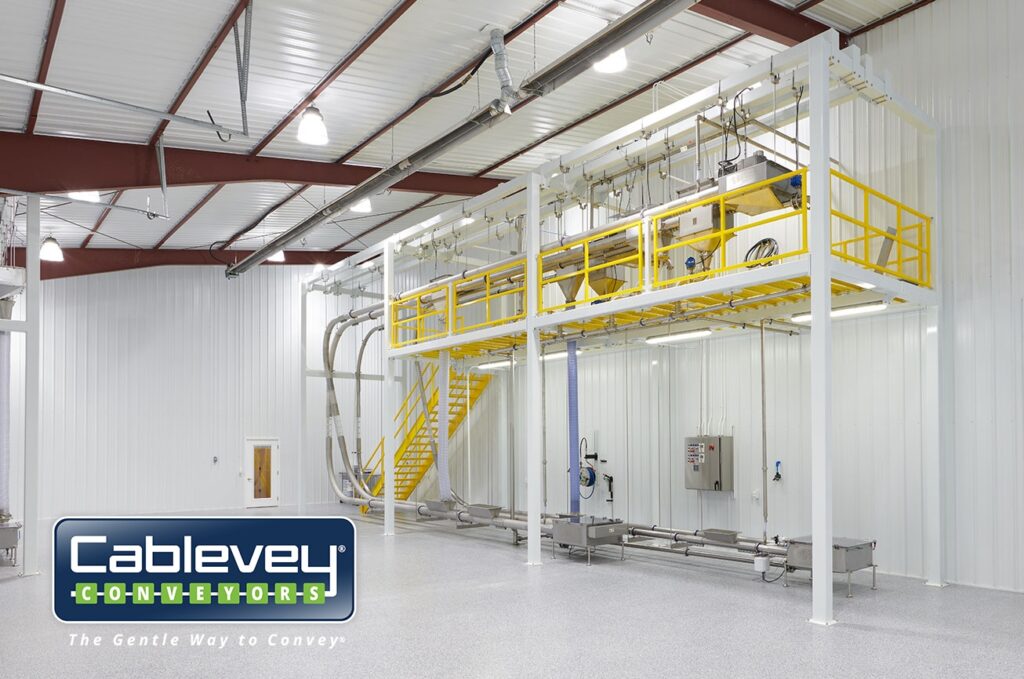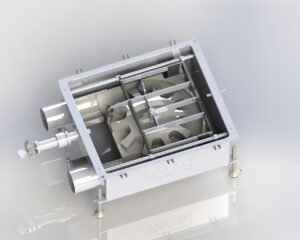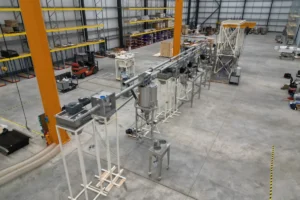In the dynamic landscape of food processing, maintaining impeccable hygiene is paramount to ensuring consumer safety and product quality. But what are the sanitary requirements of food conveyors, and how can you meet them? Here’s all you need to know for optimal material handling in industrial conveyor systems.
What Are the Sanitary Requirements of Food Conveyors?
The sanitary requirements of food conveyors encompass key considerations such as smooth surfaces, easy-to-clean materials, and minimized crevices. These features prevent the spread of contaminants, ensuring food safety and quality. Adherence to standards set by regulatory bodies like the USDA, FDA, and 3-A Sanitary Standards is crucial.
Maintaining sanitary conditions in food processing facilities is essential for food safety and the quality of food products. Foodborne illnesses can have serious consequences for consumers and can also damage a company’s reputation and financial well-being. According to the FDA, there are around 48 million cases of foodborne illness in the United States each year. Out of these, 128,000 people end up in the hospital, and 3,000 die.
Ensuring Hygienic Efficiency With Food Conveyor Solutions
Food processing facilities need to follow strict guidelines and regulations to maintain clean and hygienic conditions throughout the production process. One of the many roles of conveyor solutions in the food processing industry is to facilitate the efficient and hygienic handling of food ingredients, from raw materials to finished products, during production.
Conveyor technologies need to adhere to the strictest sanitary standards to protect the workers in the facility, the food product, consumers, and the reputation of the business.
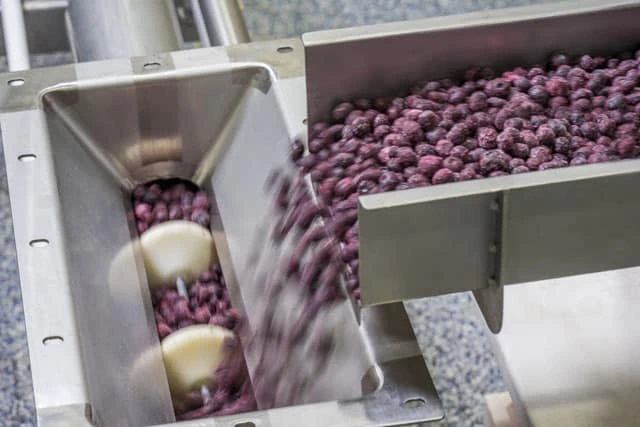
The Importance of Sanitary Design of Conveying Systems
In order to prevent the spread of contaminants and maintain the hygienic conditions of the production process, conveying systems must be designed with certain features and characteristics that enable them to meet the necessary sanitary requirements. Some of the key considerations for sanitary design include:
Smooth Surfaces
Smooth surfaces are easier to clean and disinfect than rough or textured surfaces. This helps to prevent the buildup of bacteria and other contaminants, which reduces the risk of products becoming contaminated during transport.
Additionally, smooth surfaces can help prevent damage to products that may occur due to rough or textured surfaces. This is especially important for delicate or fragile products that may be easily damaged during transport.
Easy-To-Clean Materials
Food conveying systems should be constructed with materials that are easily cleanable and disinfectable. These materials, characterized by smooth, non-porous surfaces resistant to bacteria, prevent the absorption of liquids or gases. Non-porous surfaces lack openings or pores, ensuring resistance to contaminant buildup.
An example of a material commonly used is stainless steel. This material is durable, corrosion-resistant, and can
Minimized Crevices
Crevices, or small spaces between different parts of the automated conveyor system, can be difficult to clean and can harbor bacteria and other contaminants. This can increase the risk of food products becoming contaminated during transport, which can compromise the safety and quality of the final products.
By minimizing crevices, the conveying systems can be more easily cleaned and disinfected, which helps to reduce the risk of contamination and maintain the cleanliness and hygienic conditions of the production process.
Food-Grade Lubricants
If food conveyors use lubricants, they should be food-grade and approved for use in this industry. Food-grade lubricants are specifically formulated and are approved for use in contact with this kind of product. These lubricants are free of contaminants and other impurities that could potentially contaminate the products.
Using food-grade lubricants in this kind of handling is important because it helps to prevent the contamination of the products during transport. It also helps to ensure the smooth operation of the automatic conveyor system and extend its lifespan, which can help reduce maintenance costs and improve the overall efficiency of the processing facility.
Optimizing Conveying Performance – Essential Cleaning and Maintenance Steps
Regularly scheduled cleaning and maintenance are essential for ensuring that food conveyors are operating at their best and preventing the spread of contaminants. Several steps should be taken as part of regularly scheduled cleaning and maintenance of your tubular conveyor:
- Disassemble and wash individual parts – The conveyors should be disassembled, and the individual parts should be washed with hot water and a disinfecting agent. This helps to remove any dirt, grime, or other contaminants that may have accumulated on the conveyor.
- Lubricate moving parts – Any moving parts on the food-grade conveyor should be lubricated as needed to ensure smooth operation and extend the lifespan of the conveyor.
- Inspect for wear and tear – During maintenance, it is important to inspect the food processing conveyor for signs of wear and tear, such as cracks, rust, or other damage. Any damaged parts should be repaired or replaced as needed to ensure the conveyor is operating safely and efficiently.
- Follow a regular schedule – Regularly scheduled cleaning and maintenance is key to ensuring that automated conveyor systems are operating at their best and preventing the spread of contaminants. It is important to establish a regular schedule for cleaning and maintenance and to stick to it to ensure that the conveyors are being properly cared for.
Maximizing Operations Through Automated Conveyor Maintenance
Preventing the spread of contaminants and maintaining the cleanliness and hygienic conditions of the production process is the first and a must step. However, regularly cleaning and maintaining conveyors has several other benefits:
- Improved efficiency,
- Extension of lifespan,
- Improved product quality,
- Enhanced worker safety.
Of course, all of this is difficult to achieve with manual cleaning and maintenance. This is why automated cleaning systems (such as clean-in-place mechanisms and cleaning conveyor belts) are recommended.
Sanitary Requirements for Different Types of Conveyors
Different conveyor systems manufacturers may have specific sanitary requirements for their conveying systems depending on the type of food products they are transporting. For example, food conveyors used for raw meat may have different sanitary requirements than those used for cooked food. In general, however, there are two types of sanitary guidelines a food production facility should follow – governmental guidelines and 3-A sanitary standards.
Governmental Guidelines
Every country has different institutions that set the standards for food production and safety. In the United States, there are several agencies that regulate the sanitary requirements for food conveying in food production facilities:
- United States Department of Agriculture (USDA) – The USDA is responsible for regulating the safety of meat, poultry, and egg products in the United States. This includes establishing guidelines for the sanitary handling and transport of these products, including the use of food conveyors.
- Food and Drug Administration (FDA) – The responsibility of overseeing the safety of food products in the United States falls under the FDA. This includes establishing guidelines for the sanitary handling and transport of food products, including the use of food conveyors.
- Occupational Safety and Health Administration (OSHA) – OSHA is responsible for regulating the safety and health of workers in the United States. This includes establishing guidelines for the safe operation of food conveyors and other equipment in food processing facilities.
3-A Sanitary Standards
If you’re looking to design a sanitary conveyor engineering system, the 3-A Sanitary Standards are a must-consult resource. These guidelines provide in-depth information on the construction and design of processing facilities in the food industry, including thorough descriptions and illustrations of sanitation requirements. Although the 3-A Standards are voluntary, they may be referenced in some state regulations.
These standards have been around since the 1920s and have been updated over time to incorporate new technologies, best practices, and field experience. The 3-A Standards are overseen by four associations:
- American Dairy Products Institute,
- International Dairy Foods Association,
- Food Processing Suppliers Association,
- International Association for Food Protection.
These organizations are supported by trade associations, government agencies like the USDA and FDA, and belt conveyor manufacturers. The 3-A Standards encompass various aspects, such as defining the materials permissible for manufacturing conveyor systems and establishing guidelines for the appropriate installation. They also include maintenance of equipment in contact with food products, outlining protocols for inspecting new conveying systems to guarantee their sanitary conditions.
The standards also include details on design elements like floor slope (to prevent water accumulation), types of doors on enclosures (for ease of cleaning), and light levels inside processing areas or storage rooms (for safety and better visibility).
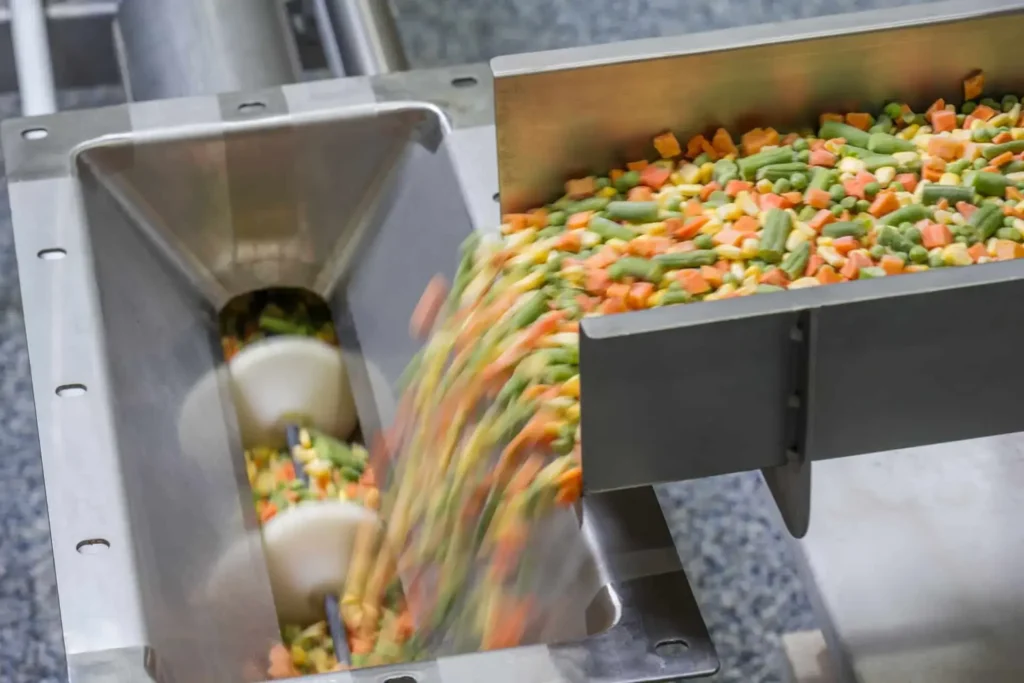
Elevate Your Operations With Sanitary Excellence of Cablevey Conveyors
The sanitary requirements of conveying systems are essential for maintaining the cleanliness, safety, and quality of food products in the food processing industry. If you’re interested in purchasing a conveyor for your food processing facility, contact us at Cablevey Conveyors. Our team is here to help you learn more about tubular cable and disc conveyors and how they can revolutionize your food processing facilities.

